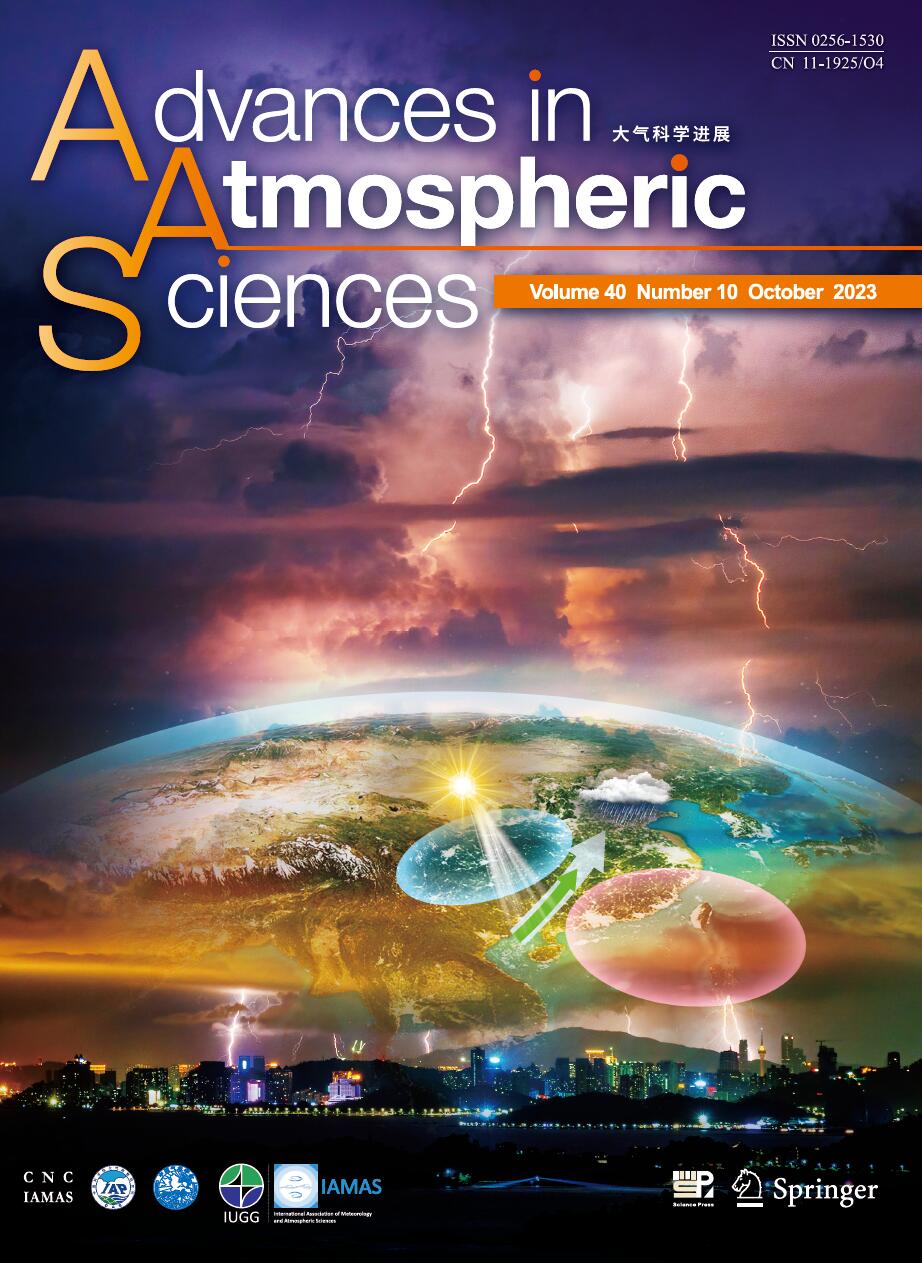| [1] |
Yiwen LI, Hailong LIU, Pengfei LIN, Eric Chassignet, Zipeng Yu, fanghua wu,
2024: Quantifying the role of the eddy transfer coefficient in simulating the response of the Southern Ocean Meridional Overturning Circulation to enhanced westerlies in a coarse-resolution model, ADVANCES IN ATMOSPHERIC SCIENCES.
doi: 10.1007/s00376-024-3278-8
|
| [2] |
PENG Jingbei, CHEN Lieting, ZHANG Qingyun,
2014: The Relationship between the El Nio/La Nia Cycle and the Transition Chains of Four Atmospheric Oscillations. Part I: The Four Oscillations, ADVANCES IN ATMOSPHERIC SCIENCES, 31, 468-479.
doi: 10.1007/s00376-013-2275-0
|
| [3] |
Zhengyu LIU,
2006: Glacial Thermohaline Circulation and Climate: Forcing from the North or South?, ADVANCES IN ATMOSPHERIC SCIENCES, 23, 199-206.
doi: 10.1007/s00376-006-0199-7
|
| [4] |
YU Yongqiang, ZHENG Weipeng, WANG Bin, LIU Hailong, LIU Jiping,
2011: Versions g1.0 and g1.1 of the LASG/IAP Flexible Global Ocean--Atmosphere--Land System Model, ADVANCES IN ATMOSPHERIC SCIENCES, 28, 99-117.
doi: 10.1007/s00376-010-9112-5
|
| [5] |
WANG Shaowu, ZHOU Tianjun, CAI Jingning, ZHU Jinhong, XIE Zhihui, GONG Daoyi,
2004: Abrupt Climate Change around 4 ka BP: Role of the Thermohaline Circulation as Indicated by a GCM Experiment, ADVANCES IN ATMOSPHERIC SCIENCES, 21, 291-295.
doi: 10.1007/BF02915716
|
| [6] |
ZhouTianjun, Zhang Xuehong, Yu Yongqiang, Yu Rucong, Liu Xiying, Jin Xiangze,
2000: Response of IAP/ LASG GOALS Model to the Coupling of Air-Sea Fresh Water Exchange, ADVANCES IN ATMOSPHERIC SCIENCES, 17, 473-486.
doi: 10.1007/s00376-000-0037-2
|
| [7] |
WU Fanghua, LIN Pengfei, LIU Hailong,
2012: Influence of a Southern Shift of the ITCZ from Quick Scatterometer Data on the Pacific North Equatorial Countercurrent, ADVANCES IN ATMOSPHERIC SCIENCES, 29, 1292-1304.
doi: 10.1007/s00376-012-1149-1
|
| [8] |
MA Hao, WU Lixin, LI Chun,
2010: The Role of Southern High Latitude Wind Stress in Global Climate, ADVANCES IN ATMOSPHERIC SCIENCES, 27, 371-381.
doi: 10.1007/s00376-009-9047-x
|
| [9] |
Zhang Xuehong, Liang Xinzhong,
1989: A Numerical World Ocean General Circulation Model, ADVANCES IN ATMOSPHERIC SCIENCES, 6, 44-61.
doi: 10.1007/BF02656917
|
| [10] |
LI Chongyin, HU Ruijin, YANG Hui,
2005: Intraseasonal Oscillation in the Tropical Indian Ocean, ADVANCES IN ATMOSPHERIC SCIENCES, 22, 617-624.
doi: 10.1007/BF02918705
|
| [11] |
LU Riyu, Buwen DONG,
2008: Response of the Asian Summer Monsoon to Weakening of Atlantic Thermohaline Circulation, ADVANCES IN ATMOSPHERIC SCIENCES, 25, 723-736.
doi: 10.1007/s00376-008-0723-z
|
| [12] |
Boyin HUANG, Vikram M. MEHTA,
2010: Influences of Freshwater from Major Rivers on Global Ocean Circulation and Temperatures in the MIT Ocean General Circulation Model, ADVANCES IN ATMOSPHERIC SCIENCES, 27, 455-468.
doi: 10.1007/s00376-009-9022-6
|
| [13] |
Zhou Guangqing, Zeng Qingcun,
2001: Predictions of ENSO with a Coupled Atmosphere-Ocean General Circulation Model, ADVANCES IN ATMOSPHERIC SCIENCES, 18, 587-603.
doi: 10.1007/s00376-001-0047-8
|
| [14] |
XU Yongfu, LI Yangchun, and CHU Min,
2013: A Global Ocean Biogeochemistry General Circulation Model and its Simulations, ADVANCES IN ATMOSPHERIC SCIENCES, 30, 922-939.
doi: 10.1007/s00376-012-2162-0
|
| [15] |
Yu Yongqiang, Yu Rucong, Zhang Xuehong, Liu Hailong,
2002: A Flexible Coupled Ocean-Atmosphere General Circulation Model, ADVANCES IN ATMOSPHERIC SCIENCES, 19, 169-190.
doi: 10.1007/s00376-002-0042-8
|
| [16] |
ZHONG Linhao, FENG Shide, GAO Shouting,
2005: Wind-Driven Ocean Circulation in Shallow Water Lattice Boltzmann Model, ADVANCES IN ATMOSPHERIC SCIENCES, 22, 349-358.
doi: 10.1007/BF02918749
|
| [17] |
Zhang Ronghua, Zeng Qingcun, Zhou Guangqing, Liang Xinzhong,
1995: A Coupled General Circulation Model for the Tropical Pacific Ocean and Global Atmosphere, ADVANCES IN ATMOSPHERIC SCIENCES, 12, 127-142.
doi: 10.1007/BF02656827
|
| [18] |
Chen Lieting,
1985: THE SOUTHERN OSCILLATION AND ITS ASSOCIATEDSUMMER RAINFALLS IN CHINA-CONCURRENTDISCUSSION OF THE RELATIONSHIP BETWEEN THE SOURTHERN OSCILLATION AND WALKER CIRCULATION, ADVANCES IN ATMOSPHERIC SCIENCES, 2, 542-548.
doi: 10.1007/BF02678752
|
| [19] |
YANG Jing, BAO Qing, WANG Xiaocong, ZHOU Tianjun,
2012: The Tropical Intraseasonal Oscillation in SAMIL Coupled and Uncoupled General Circulation Models, ADVANCES IN ATMOSPHERIC SCIENCES, 29, 529-543.
doi: 10.1007/s00376-011-1087-3
|
| [20] |
HU Ruijin, WEI Meng,
2013: Intraseasonal Oscillation in Global Ocean Temperature Inferred from Argo, ADVANCES IN ATMOSPHERIC SCIENCES, 30, 29-40.
doi: 10.1007/s00376-012-2045-4
|















 AAS Website
AAS Website 
 AAS WeChat
AAS WeChat 
 DownLoad:
DownLoad: